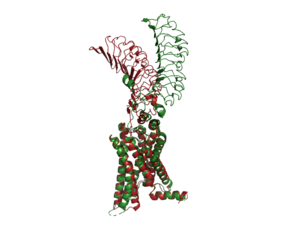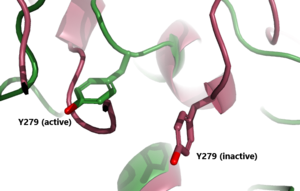Sandbox Reserved 1791
From Proteopedia
(Difference between revisions)
| Line 23: | Line 23: | ||
[https://my.clevelandclinic.org/health/body/22971-antibodies Antibodies] are an important part of the thyroid response. These proteins are made in an immune system response to get rid of unwanted antigens in the body. [https://www.btf-thyroid.org/thyroid-antibodies-explained Thyroid antibodies] are made when the body attacks the thyroid tissues. These antibodies are made to mimic [https://my.clevelandclinic.org/health/articles/23524-thyroid-stimulating-hormone-tsh-levels TSH (Thyroid Stimulating Hormone)]. TSH is released from the pituitary gland to bind to TSHR and stimulate the thyroid to make T3 and T4 hormones to regulate the metabolism. These thyroid antibodies bind to the concave surface of the LRD. | [https://my.clevelandclinic.org/health/body/22971-antibodies Antibodies] are an important part of the thyroid response. These proteins are made in an immune system response to get rid of unwanted antigens in the body. [https://www.btf-thyroid.org/thyroid-antibodies-explained Thyroid antibodies] are made when the body attacks the thyroid tissues. These antibodies are made to mimic [https://my.clevelandclinic.org/health/articles/23524-thyroid-stimulating-hormone-tsh-levels TSH (Thyroid Stimulating Hormone)]. TSH is released from the pituitary gland to bind to TSHR and stimulate the thyroid to make T3 and T4 hormones to regulate the metabolism. These thyroid antibodies bind to the concave surface of the LRD. | ||
=== M22 === | === M22 === | ||
| - | M22 is an activating antibody for [https://en.wikipedia.org/wiki/Thyrotropin_receptor TSHR]. This antibody mimics [https://my.clevelandclinic.org/health/articles/23524-thyroid-stimulating-hormone-tsh-levels TSH | + | M22 is an activating antibody for [https://en.wikipedia.org/wiki/Thyrotropin_receptor TSHR]. This antibody mimics [https://my.clevelandclinic.org/health/articles/23524-thyroid-stimulating-hormone-tsh-levels TSH] to activate the thyroid gland to produce [https://www.healthyandnaturalworld.com/t3-t4-thyroid-hormones/ T3 and T4 hormones]. M22 makes a stronger interaction with TSHR than TSH does due to a larger number of hydrogen bonds and salt bridges. This interaction is key for understanding why M22 activates TSHR and does not release TSHR to go into the inactive state even when T3 and T4 levels are high<ref name="M22"> DOI 10.1677/JME-08-0152</ref>. |
=== K1 === | === K1 === | ||
| - | [https://www.creativebiolabs.net/Anti-TSHR-Recombinant-Antibody-clone-K1-70-24911.htm K1] is an inhibitory antibody. | + | [https://www.creativebiolabs.net/Anti-TSHR-Recombinant-Antibody-clone-K1-70-24911.htm K1] is an inhibitory antibody. This antibody mimics [[https://my.clevelandclinic.org/health/articles/23524-thyroid-stimulating-hormone-tsh-levels TSH] and blocks it from binding. When K1 is bound it does not allow TSHR to be in the active state like TSH and M22 do to produce T3 and T4 hormones. |
== Active vs. Inactive State == | == Active vs. Inactive State == | ||
[[Image:Image-Inactive Inactive Proteopedia.png|300 px|right|thumb| Figure 2: An overview of the Inactive (red) vs Active (green) state of TSHR. PDB: 7WX5]] | [[Image:Image-Inactive Inactive Proteopedia.png|300 px|right|thumb| Figure 2: An overview of the Inactive (red) vs Active (green) state of TSHR. PDB: 7WX5]] | ||
Revision as of 17:36, 14 April 2023
| This Sandbox is Reserved from February 27 through August 31, 2023 for use in the course CH462 Biochemistry II taught by R. Jeremy Johnson at the Butler University, Indianapolis, USA. This reservation includes Sandbox Reserved 1765 through Sandbox Reserved 1795. |
To get started:
More help: Help:Editing |
Thyroid Stimulating Hormone Receptor (TSHR)
| |||||||||||
References
- ↑ 1.0 1.1 1.2 Faust B, Billesbolle CB, Suomivuori CM, Singh I, Zhang K, Hoppe N, Pinto AFM, Diedrich JK, Muftuoglu Y, Szkudlinski MW, Saghatelian A, Dror RO, Cheng Y, Manglik A. Autoantibody mimicry of hormone action at the thyrotropin receptor. Nature. 2022 Aug 8. pii: 10.1038/s41586-022-05159-1. doi:, 10.1038/s41586-022-05159-1. PMID:35940205 doi:http://dx.doi.org/10.1038/s41586-022-05159-1
- ↑ 2.0 2.1 Duan J, Xu P, Luan X, Ji Y, He X, Song N, Yuan Q, Jin Y, Cheng X, Jiang H, Zheng J, Zhang S, Jiang Y, Xu HE. Hormone- and antibody-mediated activation of the thyrotropin receptor. Nature. 2022 Aug 8. pii: 10.1038/s41586-022-05173-3. doi:, 10.1038/s41586-022-05173-3. PMID:35940204 doi:http://dx.doi.org/10.1038/s41586-022-05173-3
- ↑ Fokina, E.F., Shpakov, A.O. Thyroid-Stimulating Hormone Receptor: the Role in the Development of Thyroid Pathology and Its Correction. J Evol Biochem Phys 58, 1439–1454 (2022). [DOI:10.1134/S0022093022050143 https://doi.org/10.1134/S0022093022050143]
- ↑ Chen CR, McLachlan SM, Rapoport B. Thyrotropin (TSH) receptor residue E251 in the extracellular leucine-rich repeat domain is critical for linking TSH binding to receptor activation. Endocrinology. 2010 Apr;151(4):1940-7. doi: 10.1210/en.2009-1430. Epub 2010 Feb 24. PMID: 20181794; PMCID: PMC2851189. [DOI 10.1210/en.2009-1430 https://www.ncbi.nlm.nih.gov/pmc/articles/PMC2851189/]
- ↑ Nunez Miguel R, Sanders J, Chirgadze DY, Furmaniak J, Rees Smith B. Thyroid stimulating autoantibody M22 mimics TSH binding to the TSH receptor leucine rich domain: a comparative structural study of protein-protein interactions. J Mol Endocrinol. 2009 May;42(5):381-95. Epub 2009 Feb 16. PMID:19221175 doi:10.1677/JME-08-0152
- ↑ Smits G, Govaerts C, Nubourgh I, Pardo L, Vassart G, Costagliola S. Lysine 183 and glutamic acid 157 of the TSH receptor: two interacting residues with a key role in determining specificity toward TSH and human CG. Mol Endocrinol. 2002 Apr;16(4):722-35. doi: 10.1210/mend.16.4.0815. PMID: 11923469. [DOI: 10.1210/mend.16.4.0815 https://pubmed.ncbi.nlm.nih.gov/11923469/]
- ↑ 7.0 7.1 Chiovato L, Magri F, Carlé A. Hypothyroidism in Context: Where We've Been and Where We're Going. Adv Ther. 2019 Sep;36(Suppl 2):47-58. doi: 10.1007/s12325-019-01080-8. Epub 2019 Sep 4. PMID: 31485975; PMCID: PMC6822815. [DOI: 10.1007/s12325-019-01080-8 https://pubmed.ncbi.nlm.nih.gov/31485975/]
![Figure 1: An overview of the Thyroid System. A depiction of signaling cascade from the hypothalamus ending in the release of TSH causing T3 and T4 production and its effects. The mechanism of regulation also shown by negative feedback from the T3 and T4 hormones. Source: [1]](/wiki/images/thumb/1/1d/TSH_system1.png/300px-TSH_system1.png)


![Figure 4: T3 and T4 role in TSH concentration: Highlighting the problem when under or overactive on the metabolism. When an antibody is bound to TSHR and cannot respond to the negative feedback look the metabolism experiences a shift outside of equilibrium resulting in a wide array of side effects. [2]](/wiki/images/thumb/5/5f/T3t4levels.jpeg/400px-T3t4levels.jpeg)
